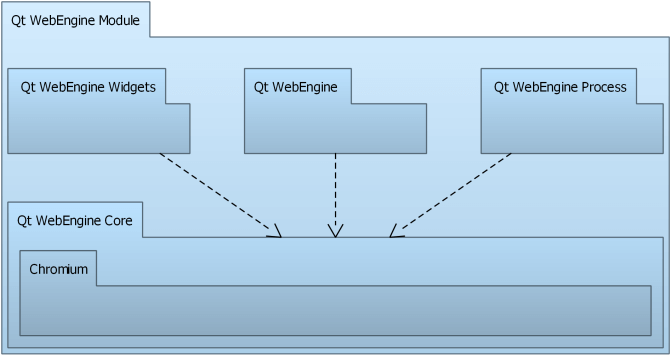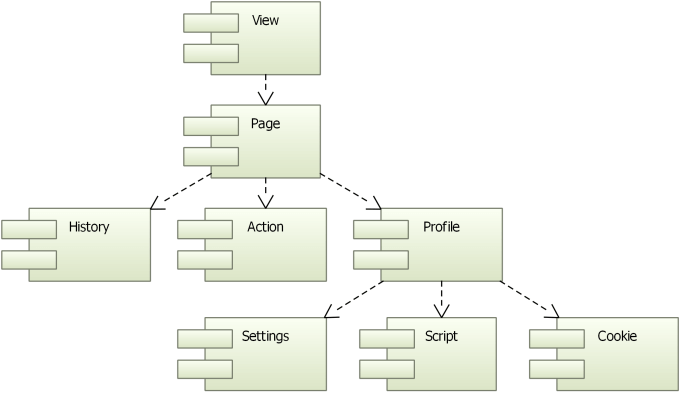Qt WebEngine模块提供了一个web浏览器, 在不使用本地浏览器的情况下, 它可以很容易地把Web内容嵌入到Qt应用程序中.
Qt WebEngine为渲染HTML, XHTML和SVG文档, 使用CSS和JavaScript, 提供了C++类和QML类型
Qt WebEngine架构

Qt WebEngine的功能分成下列模块:
- Qt WebEngine Widgets 模块: 用于创建基于Widget的web应用.
- Qt WebEngine 模块: 用于创建基于Qt Quick的web应用.
- Qt WebEngine Core 模块: 与Chromium交互
页面(Page)渲染和JavaScript执行从GUI进行分离到了Qt WebEngine进程. 它是一个独立的应用库.
Qt WebEngine Widgets 模块

一个web engine view 是Qt WebEngine模块的主要Widget. 它可以在各种各样的应用中加载网页内容. 在视图(view)里, 一个web engine page有一个主frame, 它响应网页内容, 浏览链接历史以及操作(actions). view 和 page 非常相似, 它们提供一组公共函数.
所有pages都属于web engine profile(配置), 它包含共享设置, 脚本和cookies. Profiles可以使用页面分离. 一个典型应用是专用浏览模式的专用配置文件,其中没有永久保存的信息.
备注: Qt WebEngine Widgets 模块使用 Qt Quick场景图来构成视图中的网页元素。这意味这UI进程需要OpenGL ES 2.0或OpenGL 2.0来进行渲染.
A web engine view is the main widget component of the Qt WebEngine module. It can be used in various applications to load web content. Within a view, a web engine page holds a main frame that is responsible for web content, the history of navigated links, and actions. The view and page are quite similar, as they provide a set of common functions.
All pages belong to a web engine profile that contains shared settings, scripts, and cookies. Profiles can be used to isolate pages from each other. A typical use case is a dedicated profile for a private browsing mode, where no information is permanently saved.
Note: The Qt WebEngine Widgets module uses the Qt Quick scene graph to compose the elements of a web page into one view. This means that the UI process requires OpenGL ES 2.0 or OpenGL 2.0 for its rendering.
Qt WebEngine Core Module
Qt WebEngine core基于Chromium项目.
备注: Qt WebEngine基于Chromium, 但是没有包含或使用任何Chrome浏览器的其它服务和插件. 你可以在Chromium项目源代码库查看Chromium和Chrome的区别.
Qt5.9.1中的 Qt WebEngine基于Chromium 56.0.2924.122, 以及额外的安全更新.
The Qt WebEngine core is based on the Chromium Project. Chromium provides its own network and painting engines and is developed tightly together with its dependent modules.
Note: Qt WebEngine is based on Chromium, but does not contain or use any services or add-ons that might be part of the Chrome browser that is built and delivered by Google. You can find more detailed information about the differences between Chromium and Chrome in this overview that is part of the documentation in the Chromium Project upstream source tree.
This version of Qt WebEngine is based on Chromium version 56.0.2924.122, with additional security fixes from newer versions.
Qt WebEngine Process
The Qt WebEngine Process is a separate executable that is used to render web pages and execute JavaScript. This mitigates security issues and isolates crashes caused by specific content.
基于Widget的应用 Embedding Web Content into Widget Based Applications
使用QWebEngineView来显示网页非常简单, 示例如下:
Use the QWebEngineView class to display web pages in the simplest way. Because it is a widget, you can embed QWebEngineView into your forms and use its convenience functions to download and display web sites.
QWebEngineView *view = new QWebEngineView(parent); view->load(QUrl("http://www.qt.io/")); view->show();
一个QWebEngineView 实例有一个QWebEnginePage. QWebEnginePage有一个QWebEngineHistory(页面的浏览历史)和一些用于操作页面的QAction对象. 此外, QWebEnginePage可以在页面的主框架内运行JavaScript代码以及为特定事件使用自定义处理器(比如显示自定义授权对话框).
An instance of QWebEngineView has one QWebEnginePage. QWebEnginePage can have a QWebEngineHistory that provides access to the page's navigation history and several QAction objects that apply actions on the web page. In addition, a QWebEnginePage has the ability to run JavaScript code in the context of the page's main frame and to enable customization of handlers for specific events like showing custom authentication dialogs.
每一个QWebEnginePage都属于一个QWebEngineProfile, QWebEngineProfile有一个页面设置的QWebEngineSettings, 一个在页面上运行脚本的QWebEngineScriptCollection, 一个访问HTTP cookies的QWebEngineCookieStore . QWebEnginePage 可以直接指定脚本集合.
Each QWebEnginePage belongs to a QWebEngineProfile that can have a QWebEngineSettings for specifying page settings, a QWebEngineScriptCollection for running scripts on the page, and a QWebEngineCookieStore for accessing the HTTP cookies of Chromium. A QWebEnginePage can also directly point to a script collection.
对于基于widget的应用, web engine会自动初始化, 除非把它放在插件中. 在这种情况下, 它必须在应用程序主文件中用QtWebEngine::initialize初始化, 示例代码如下:
For a widget based application, the web engine is automatically initialized, unless it is placed in a plugin. In that case, it must be initialized in the application main source file by using QtWebEngine::initialize, as illustrated by the following code snippet:
int main(int argc, char **argv) { QApplication app(argc, argv); QtWebEngine::initialize(); QMainWindow window; window.show(); return app.exec(); }
Embedding Web Content into Qt Quick Applications
The WebEngineView QML type allows Qt Quick applications to render regions of dynamic web content. A WebEngineView type may share the screen with other QML types or encompass the full screen as specified within the Qt Quick application.
To make sure that OpenGL context can be shared between the GUI and render processes, the web engine must be initialized by using QtWebEngine::initialize in the application main source file, as illustrated by the following code snippet:
int main(int argc, char *argv[]) { QCoreApplication::setAttribute(Qt::AA_EnableHighDpiScaling); QGuiApplication app(argc, argv); QtWebEngine::initialize(); QQmlApplicationEngine engine; engine.load(QUrl(QStringLiteral("qrc:/main.qml"))); return app.exec(); }
应用程序可以使用URL和HTML字符串加载页面到WebEngineView, 并使用事务历史进行导航. 在默认情况下, 不同页面的链接会加载到相同的WebEngineView对象, 但是web sites可能会请求打开新的tab, window和dialog.
An application can load pages into the WebEngineView, using either an URL or HTML string, and navigate within session history. By default, links to different pages load within the same WebEngineView object, but web sites may request them to be opened as a new tab, window, or dialog.
The following sample QML application loads a web page using the url property:
import QtQuick 2.0 import QtQuick.Window 2.0 import QtWebEngine 1.0 Window { 1024 height: 750 visible: true WebEngineView { anchors.fill: parent url: "http://www.qt.io" } }
Script Injection
Qt WebEngine不允许直接操作页面DOM. 然而,DOM可以通过注入脚本来检查和调整。
Qt WebEngine does not allow direct access to the document object model (DOM) of a page. However, the DOM can be inspected and adapted by injecting scripts.
在文档ready(一般是页面加载完成)时, 页面Dom构建完成, . 因此, 在文档创建时立刻执行脚本对DOM操作并不适合, 只有在DOM准备好之后再执行脚本.
The DOM of a page is constructed when the document is ready, typically when the page is completely loaded. Therefore, executing scripts as soon as a document is created is not suitable for DOM operations, where one has to wait until the DOM is ready.
另外, 注入脚本与页面上运行的其它脚本共享同一个世界, 这意味着可能引起代码冲突. 为避免它, QWebEngineScript和WebEngineScript QML类型提供了Chromium API 的 Content Script Extensions实现.
In addition, an injected script shares the same world as the other scripts executed on the page, which might lead to conflicts. To avoid this, the QWebEngineScript class and the WebEngineScript QML type provide implementations of the Chromium API for Content Script Extensions. They specify the script to run, the injection point, and the world where the script is run. This enables accessing the DOM to manipulate it within a world.
The following Greasemonkey attributes are supported since Qt 5.8: @exclude, @include, @name, @match, and @run-at.
Managing Certificates
Qt WebEngine uses its own network stack, and therefore QSslConfiguration is not used to open SSL connections. Instead, Qt WebEngine uses the root CA certificates from the operating system to validate the peer's certificate.
The WebEngineCertificateError::error and QWebEngineCertificateError::Error enumerations provide information about the types of certificate errors that might occur. The errors can be handled by using the WebEngineView::certificateError QML method or by reimplementing the QWebEnginePage::certificateError function.
Proxy Support
Qt WebEngine uses the proxy settings from Qt Network, and forwards them to Chromium's networking stack. If QNetworkProxy::applicationProxy is set, it will also be used for Qt WebEngine. If QNetworkProxyFactory::usesSystemConfiguration() is enabled, the proxy settings are automatically retrieved from the system. Settings from an installed QNetworkProxyFactory will be ignored, though.
Not all properties of QNetworkProxy are supported by Qt WebEngine. That is, QNetworkProxy::type(), QNetworkProxy::hostName() and QNetworkProxy::port() are taken into account. All other proxy settings such as QNetworkProxy::rawHeader(), QNetworkProxy::user(), or QNetworkProxy::password() are ignored.
If a proxy requires authentication, QWebEnginePage::proxyAuthenticationRequired is emitted. For Qt Quick, a dialog is shown.
高分辨率支持 High DPI Support
To support High DPI devices, it is recommended that the application attribute Qt::AA_EnableHighDpiScaling is set to enable automatic scaling based on the pixel density of the monitor. In Qt WebEngine applications, the scaling affects the default zooming factor and scrollbar size.
For example:
int main(int argc, char *argv[]) { QCoreApplication::setAttribute(Qt::AA_EnableHighDpiScaling); QApplication app(argc, argv); // ... }
Qt WebEngine bundles images for normal and high-dpi resolutions into qtwebengine_resources_100p.pak and qtwebengine_resources_200p.pak files. Depending on the target resolutions, one or both of these files need to be deployed.
For more information, see High DPI Displays.
Using WebEngine Core
Qt WebEngine Core provides an API shared by Qt WebEngine and Qt WebEngine Widgets for handling URL requests issued for the networking stack of Chromium and for accessing its HTTP cookies.
Implementing the QWebEngineUrlRequestInterceptor interface and installing the interceptor on a profile enables intercepting, blocking, and modifying URL requests (QWebEngineUrlRequestInfo) before they reach the networking stack of Chromium.
A QWebEngineUrlSchemeHandler can be registered for a profile to add support for custom URL schemes. Requests for the scheme are then issued to QWebEngineUrlSchemeHandler::requestStarted() as QWebEngineUrlRequestJob objects.
The QWebEngineCookieStore class provides functions for accessing HTTP cookies of Chromium. The functions can be used to synchronize cookies with QNetworkAccessManager, as well as to set, delete, and intercept cookies during navigation.
Platform Notes
Qt WebEngine currently supports only Windows, Linux, and macOS. Due to Chromium build requirements it also often requires a newer compiler than the rest of Qt. See Qt WebEngine Platform Notes for further details.
Related Modules
Qt WebEngine supersedes the Qt WebKit module, which is based on the WebKit project, but has not been actively synchronized with the upstream WebKit code since Qt 5.2 and has been deprecated in Qt 5.5. For tips on how to change a Qt WebKit widgets application to use Qt WebEngine widgets, see Porting from Qt WebKit to Qt WebEngine.
The Qt WebView module allows to use a native web browser on platforms where one is available.
The Qt WebChannel module can be used to create a bi-directional communication channel between QObject objects on the C++ side and JavaScript on the QML side.